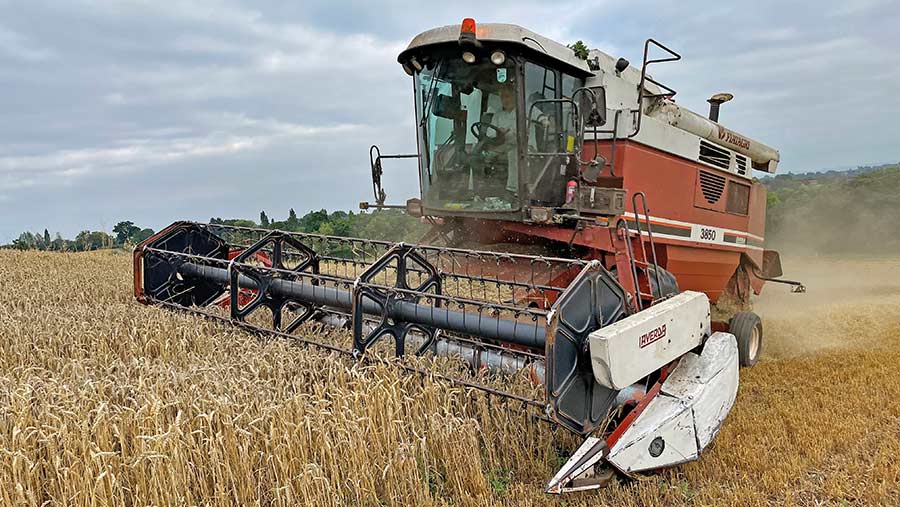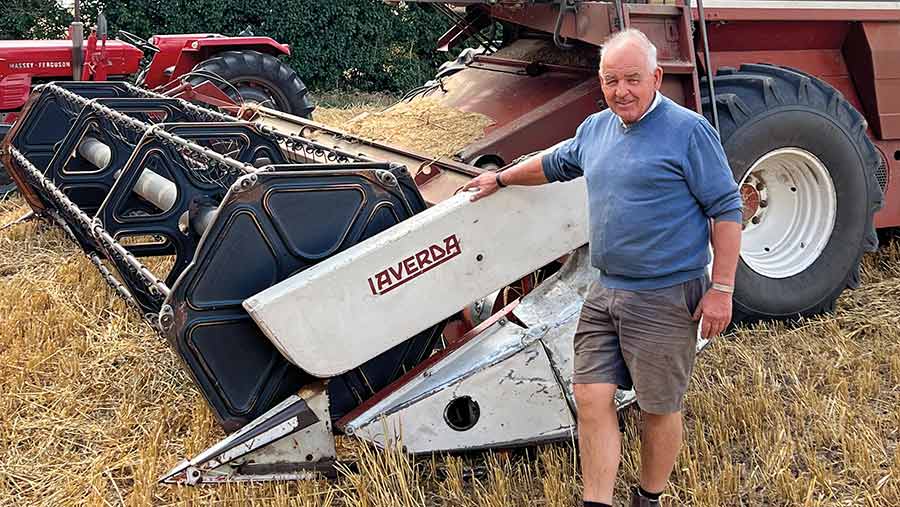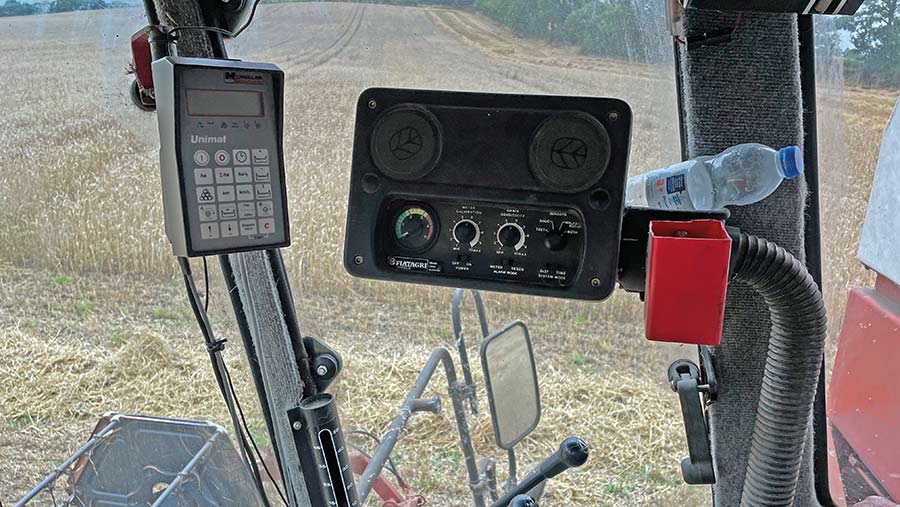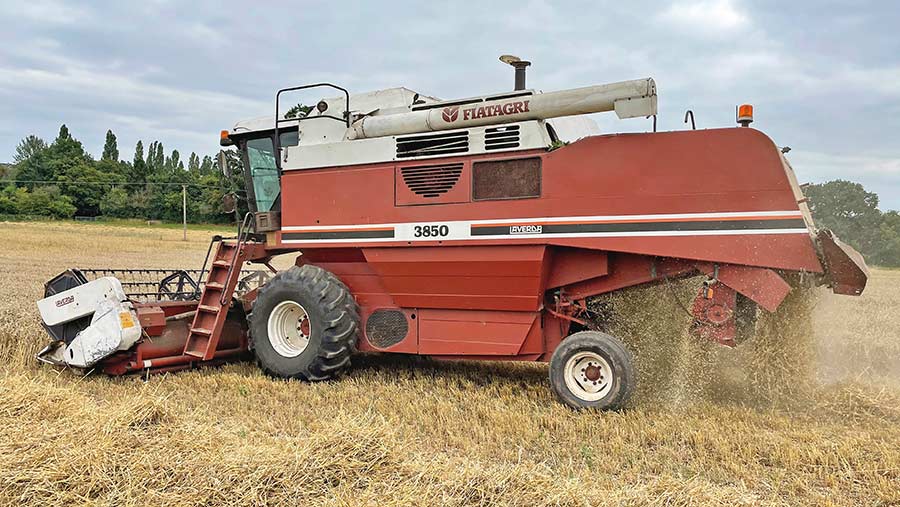Driver’s view: Robert Floyd’s 1989 Laverda 3850 combine
 © James Andrews
© James Andrews A 1989 Laverda 3850 has been the combine of choice for Worcestershire mixed farmers Robert Floyd and James Kent for the past 13 years.
The Italian-built harvester cuts about 80ha of their own cereals, plus up to 40ha for neighbouring farmers, depending on the year.
To find out how it has performed, we caught up with driver Mr Floyd as he and the machine were sawing their way through the 2022 wheat harvest.
See also: Machinery Milestones: History of the combine harvester
Robert Floyd’s Laverda 3850
- Year 1989
- Years owned 13
- Hours Approx 2,800
- Engine 8-litre, six-cylinder Iveco
- Power 180hp
- Transmission Manual with variable speed pulleys
- Header 2 x 18ft, one with oilseed rape extensions
- Threshing Single drum and six straw walkers
- Price paid £10,000
What made you choose a Laverda 3850?

© James Andrews
I’m a big fan of Laverda combines and have had them for years. They’re a bit like Skoda cars – not very fancy, but they get you home.
The combine before this was a five-walker 3750; it had been a good machine, but was starting to get tired and the cab was a bit basic.
I started looking for a replacement and had my heart set on a 3790 with hydrostatic transmission.
These are considerably nicer to drive, but they’re more expensive and they’re getting hard to find these days.
There weren’t that many in the country to start with and a lot have been exported now.
Eventually, I came across this 1989 3850 which, with six walkers and an 18ft header, gave us a bit more output.
It sits about 25cm wider than the old five-walker machine, but we’ve got decent access to most of our fields, so this hasn’t proved to be a problem.
The combine was for sale with Laverda specialist David Rushton, based in Uttoxeter, Staffordshire, and it had spent its entire life on one local farm, which I liked.
It was on 1,800 hours and cost £10,000. Ours was traded in for £3,000, so the upgrade came to just £7,000.
We also got hold of a second header that’s been adapted with an 80cm extension for oilseed rape.

© James Andrews
How has it performed?
For the price we paid performance is excellent, and it will happily cut wheat at 4-5kph while giving a decent sample.
This equates to about 1.6ha/hour, so we can cover the ground surprisingly quickly. It’s possible to cut 100t of wheat in a day, but our average is more like 80-90t.
Power is ample as it has a bomb-proof 8-litre, six-cylinder Iveco engine that develops about 180hp.
It’s economical, too, burning about 2 litres of diesel to the hectare. Hydrostatic machines like the 3790 we wanted take more power to drive and use a good bit more fuel as a result.
Unlike modern fly-by-wire machines, it’s a bit seat-of-the-pants to drive. When I’m cutting the headland or the header blocks, I have to shunt between forwards and reverse every now and again.
The gearbox isn’t the slickest for this, but you soon get used to it – the trick is to ease it forward or back on the clutch to make the change a bit easier.
Once the field is opened up I can cruise around without stopping very often, so it’s not much of an inconvenience.
The cab is surprisingly comfortable, the air conditioning works a treat, and everything functions as it should, including the grain loss monitors.
There’s also a handy feature that allows you to peer into the returns from the seat so you can see what sort of a job you’re doing.

© James Andrews
Is it reliable?
It’s an old combine, so we expect the odd breakdown. However, it’s now on its 10th season with us, cutting a total of about 1,000ha, and we’ve rarely had to spend our budgeted £2/ha (£5/acre) a year on repair costs.
We had a couple of problems in the first season, with the clutch going and a few other bits and pieces that racked up a bill of about £5,000.
It has also had a couple of unloading auger gearboxes at about £200 apiece, but I think this is because it had been knocked in the past and was slightly out of alignment.
Another issue was knife sections breaking prematurely, but after upgrading to thicker 4mm versions with bolts rather than rivets, there hasn’t been a problem.
Other than that, it’s minor niggles that rarely stop us for long. Most years we’ll have to do some running repairs but, occasionally, we get a year where it sails through without any faults.
Before the start of this season, we bought a new front wheel and tyre for £500, as the sidewall was cracked on one of ours, and another set of rape sieves for £150, as the set that came with the combine was well worn.
What is spare parts supply like?
Parts supply is very good, thanks to David Rushton Machinery in Uttoxeter, Staffordshire. He has a decent stock of salvaged and new bits, so we rarely have to wait for a delivery.
It’s a good hour-and-a-half drive to get there, though, and we can make quite a few trips some years.
We do most of our own servicing and some of the simpler fixes, but we also get help from local mechanic James Green.
How long are you going to keep it?
The combine is cutting its 12th season for us and the plan is to keep it until it dies. It copes fine with the area we’ve got to cut, so we can’t see any reason to spend more money on something flashier.
Plus, more modern combines have so many electrics to go wrong – this is almost all mechanical, with levers to control everything and a simple set of gauges in the cab.
The most sophisticated bit of technology is the grain loss monitor, which is nice to have, but not essential.
